Diabetes in cats is a chronic and common endocrine disorder that affects their ability to regulate blood sugar levels. It occurs when the body either does not produce enough insulin (Type 1 diabetes) or when the cells become resistant to insulin’s effects (Type 2 diabetes). Insulin is a hormone produced by the pancreas that helps regulate the amount of glucose (sugar) in the blood.
1. Diabetes (Insulin-Dependent Diabetes):
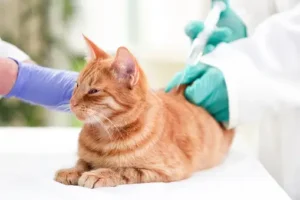
Type 1 diabetes occurs when the pancreas fails to produce enough insulin, a hormone that helps regulate glucose levels in the blood. This can be due to destruction or dysfunction of the insulin-producing beta cells in the pancreas. Cats with type 1 diabetes require regular insulin injections to manage their blood sugar levels effectively.
2. Diabetes (Non-insulin Dependent Diabetes):
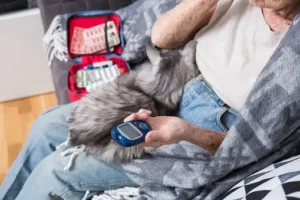
Type 2 diabetes in cats is characterized by insulin resistance, meaning that the cat’s body doesn’t respond properly to the insulin produced by the pancreas. Over time, the pancreas may also become unable to produce enough insulin. Initially, diet and oral medications may be used to manage type 2 diabetes in cats. In some cases, insulin injections may eventually become necessary.
It is essential to note that while these are the main types of diabetes in cats, there are other less common forms, including transient diabetes and secondary diabetes, which can occur due to other medical conditions or medications. Regular veterinary check-ups and monitoring of your cat’s health can help identify diabetes early and ensure proper management to maintain their well-being. If you suspect your cat may have diabetes or notice any concerning symptoms, it’s crucial to consult a veterinarian for a proper diagnosis and appropriate treatment plan.
May Be You Like It: 3 Wonderful Facts Of Dental Disease in Cats
Symptoms of Diabetes in Cats:
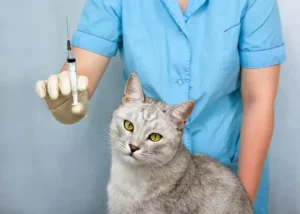
- Increased Thirst (Polydipsia): Cats with diabetes may drink more water than usual due to increased sugar levels in their bloodstream.
- Frequent Urination (Polyuria): The increased water intake leads to increased urine production, resulting in more frequent trips to the litter box.
- Increased Appetite (Polyphagia): Despite eating more, diabetic cats may lose weight or have difficulty gaining weight. The body is not able to utilize the glucose effectively, leading to a feeling of constant hunger.
- Weight Loss: Due to the inability to use glucose properly, the body breaks down fat and muscle for energy, leading to weight loss even with increased appetite.
- Lethargy and Weakness: Cats with diabetes may become lethargic, less active, and may tire easily.
- Vomiting and Dehydration: In severe cases or when diabetes is left untreated, it can lead to vomiting and dehydration.
- Poor Coat Condition: Diabetic cats may have a dull or scruffy-looking coat, and their skin may be dry and flaky.
- Change in Gait: Some cats may develop a plantigrade stance, where they walk on their hocks instead of their toes. This is more common in diabetic cats with neuropathy.
If you notice any of these symptoms in your cat, it’s essential to consult a veterinarian for a thorough evaluation and appropriate treatment. Early diagnosis and management are crucial in improving the prognosis and quality of life for diabetic cats.
I Hope You Like It: Why Grooming is essential for Pets
Diagnosis and Management:
Diagnosing and managing diabetes in cats involves a combination of clinical evaluation, laboratory tests, and a comprehensive treatment plan. Here’s an overview of the diagnosis and management process:
Diagnosis:
- Medical History and Physical Examination: The veterinarian will start by taking a detailed medical history and performing a physical examination of the cat to assess any clinical signs of diabetes.
- Blood Glucose Testing: A definitive diagnosis of diabetes in cats is based on elevated blood glucose levels. The vet will measure the cat’s blood glucose concentration, typically through a blood sample obtained by pricking the cat’s ear or a vein.
- Urine Analysis: A urine sample will be collected to check for the presence of glucose and other substances that may indicate diabetes.
- Fructosamine Test: In some cases, a fructosamine test may be performed, which measures the average blood glucose levels over the previous two to three weeks.
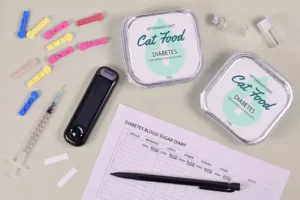
Management:
Once a cat is diagnosed with diabetes, the primary goals of treatment are to regulate blood glucose levels, manage symptoms, and improve the cat’s overall quality of life. The management plan typically includes the following components:
- Insulin Therapy (Type 1 Diabetes): Cats with Type 1 diabetes require insulin injections to control their blood sugar levels. The veterinarian will determine the appropriate insulin type, dosage, and frequency based on the cat’s individual needs. Insulin injections are usually administered under the skin, and the cat’s response to treatment is closely monitored.
- Dietary Management: A consistent and appropriate diet is crucial in managing feline diabetes. High-protein, low-carbohydrate diets are often recommended, as they help stabilize blood glucose levels and reduce insulin requirements. Feeding should be consistent with regular meal times to match insulin administration.
- Weight Management: Maintaining a healthy weight is essential for diabetic cats. If the cat is overweight, the vet may recommend a weight loss plan to improve insulin sensitivity.
- Monitoring Blood Glucose: Regular monitoring of blood glucose levels at home or at the veterinarian’s clinic is essential to adjust insulin dosages and assess treatment effectiveness. This helps fine-tune the treatment plan to achieve better glucose control.
- Exercise and Environmental Enrichment: Encouraging regular exercise and providing a stimulating environment can help improve insulin sensitivity and overall well-being.
- Regular Vet Check-ups: Diabetic cats require regular follow-up visits to the veterinarian for monitoring and adjustments to the treatment plan as needed.
Do You Want to Know About: 5 Important Things About Kidney Disease in Cats
Treatment of Diabetes in Cats:
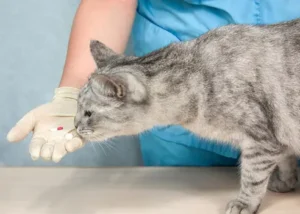
- Insulin Therapy: If your cat has Type 1 diabetes or severe Type 2 diabetes that does not respond well to other treatments, insulin therapy is essential. Insulin is usually administered as subcutaneous injections (under the skin). The dosage and frequency of insulin injections will be determined by your veterinarian based on your cat’s specific needs. It’s important to follow the prescribed schedule and dosage strictly.
- Dietary Management: A balanced and consistent diet is crucial for diabetic cats. High-quality cat food that is low in carbohydrates and moderate in fat and protein is often recommended. Consistent feeding times and portion control are essential to help regulate blood sugar levels. Your veterinarian may recommend prescription diets formulated for diabetic cats.
- Weight Management: If your cat is overweight, weight loss may be necessary to improve insulin sensitivity and overall health. Your vet can help you create a safe and gradual weight loss plan.
- Exercise: Regular, controlled exercise can help improve insulin sensitivity and aid in weight management. Engage your cat in play and exercise activities appropriate for their age and health condition.
- Monitoring Blood Glucose: Regular monitoring of blood glucose levels is crucial to adjust insulin dosage and assess the effectiveness of treatment. Your veterinarian may teach you how to perform at-home glucose monitoring, or you may need to bring your cat in for periodic check-ups.
- Stress Reduction: Minimize stress in your cat’s environment, as stress can affect blood glucose levels. Provide a suitable environment.
- Medication Adjustments: If your cat is on other medications, it’s essential to work with your veterinarian to ensure they won’t interfere with diabetes treatment.
You Should Want To Know About: 12 Important Effects of Skin Fungal Infection In Cats
FAQ’s:
Q: What is feline diabetes?
Feline diabetes is a condition in which a cat’s body either doesn’t produce enough insulin or becomes resistant to insulin, leading to high blood glucose levels. This can result in various health complications if left untreated.
Q: What are the common signs of diabetes in cats?
Some common signs of diabetes in cats include increased thirst and urination, weight loss despite a ravenous appetite, lethargy, and changes in behavior. If you notice these symptoms, it’s essential to consult a veterinarian for a proper diagnosis.
Q: Are certain cat breeds more prone to developing diabetes?
Yes, certain cat breeds, such as Burmese, Siamese, and Maine Coons, have a higher predisposition to diabetes. Additionally, overweight or obese cats are at a greater risk of developing the condition.
Q: Can feline diabetes be managed with diet and lifestyle changes alone?
In some cases, early-stage diabetes can be managed with diet and lifestyle changes, such as a controlled low-carbohydrate diet and regular exercise. However, many cats will require insulin therapy to regulate blood sugar levels effectively.
Q: How is feline diabetes diagnosed and treated?
Diagnosis involves a thorough physical examination, blood tests to measure glucose levels, and urine analysis to detect glucose and ketones. Treatment typically involves insulin injections, tailored diet plans, and regular monitoring of the cat’s blood glucose levels to ensure proper management of the condition.
Must Visit: Vetpomedix.com


